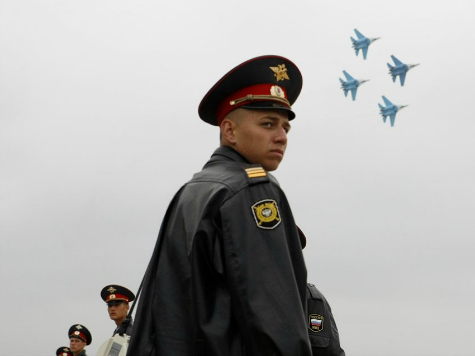
Russia moved dozens of Mig-29 and Su-27 fighter aircraft and Tu-22 bombers from a Simferopol district airbase to the western coast of the Crimean peninsula on May 3rd following the bloody clashes between pro- and anti-Russian groups in the southern coastal city of Odessa where 42 people were killed and 125 injured the day before.
Despite some success by Ukrainian security forces in dislodging separatists in eastern Ukraine, pro-Russia groups stormed the Ukrainian Security Service building in the eastern city of Donetsk Sunday, looting weapons and burning the Ukrainian flag, according to the Sunday London Times.
Pro-Russian groups still control more than a dozen buildings in the Donetsk and Luhansk regions. Stratfor Global Intelligence service estimates there are no more than a couple of hundred well-armed militia currently occupying buildings and manning checkpoints throughout eastern Ukraine, but there are thousands of unarmed civilians supporting the separatists in their strongholds in the two easternmost provinces of Luhansk and Donetsk. A standoff has ensued between the separatists and Ukrainian security forces in anticipation of the upcoming May Day holidays on May 9-11, a high point of Soviet nostalgia in the region.
Acting Ukrainian President Oleksandr Turchynov said April 30 that the country’s security forces are unable to “take the situation in the Donetsk and Luhansk regions under control,” adding that the Ukrainian army has been put on combat alert.
Despite an agreement in Geneva for the separatists to disarm in exchange for constitutional protections for minorities, neither side has made any meaningful changes on the ground. Ukraine is interested in maintaining territorial integrity, and Moscow’s main imperative is to keep Ukraine neutralized from meaningfully integrating with the West.
The Ukrainian Parliament is currently deliberating a referendum on the decentralization of power, possibly to coincide with Ukraine’s presidential elections set for May 25. Russia had previously said it would not recognize these elections, but in an April 29 interview with Russian daily Gazeta.ru the Russian Deputy Foreign Minister Sergei Ryabkov said Moscow could recognize the elections “depending on how they are held.”
Moscow has 40,000 Russian troops massed along the Ukrainian border, supposedly mobilized under the pretense of military exercises. Stratfor believes that the threat of military intervention is much more effective as a source of leverage for Russia: “The immense logistical and political constraints involved in actually invading Ukraine likely preclude direct Russian action.”
Russia increased its military exercises near the border after Ukrainian forces began their anti-terrorism activities, compelling Kiev to back down from carrying out such operations and relinquishing checkpoints the military previously seized.
Russian Defense Minister Sergei Shoigu held a phone conversation with U.S. Secretary of Defense Chuck Hagel on April 28 and said that Russia would not intervene in Ukraine militarily as long as Kiev does not use its own military against unarmed civilians. However, after the horrific violence in Odessa, Russia has moved its aircraft into attack positions for if the Ukrainian military continues to advance.
The author welcomes feedback and will respond to comments by readers.

COMMENTS
Please let us know if you're having issues with commenting.